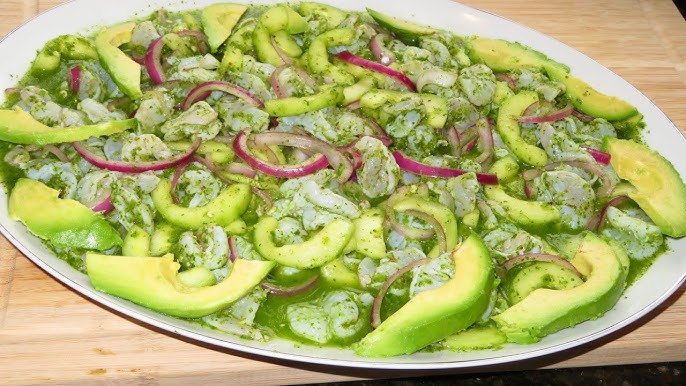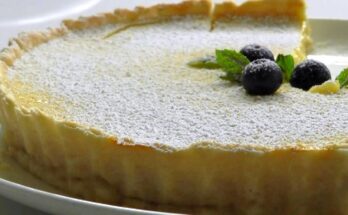Aguachile Recipe: Aguachile is like ceviche’s fiery cousin — bold, zesty, and absolutely refreshing. Hailing from the western regions of Mexico, particularly Sinaloa, this dish features raw shrimp “cooked” in a vibrant blend of lime juice, green chiles, and fresh herbs. Unlike ceviche, which typically has a longer marinating time, aguachile is much quicker, focusing on freshness and spice. It’s not just a dish; it’s an experience — one that hits you with citrusy sharpness and a spicy punch in each bite.
This appetizer is popular at seafood stands and family gatherings, often served chilled on a bed of cucumbers with crunchy tostadas on the side. It’s perfect for hot summer days, weekend brunches, or anytime you’re craving something refreshing but flavorful.
Origin and Cultural Significance
Aguachile isn’t just another seafood dish — it’s deeply tied to coastal Mexican cuisine. Originating in Sinaloa, a state known for its seafood-rich traditions, aguachile reflects the essence of beachside cooking: fast, fresh, and fiery. The word itself combines “agua” (water) and “chile,” pointing directly to its spicy-lime liquid base.
Historically, it was made by indigenous communities using wild chiltepín peppers and minimal ingredients to preserve the natural flavors of freshly caught seafood. Over the years, the recipe evolved, embracing new ingredients and preparation styles, but the heart of the dish remains the same — a love for spice and sea.
In modern Mexican cuisine, aguachile is not just street food — it’s also celebrated in upscale restaurants and featured in culinary festivals. It bridges tradition with modern food trends, especially with health-conscious diners who appreciate clean, raw, and protein-rich meals.
Why You’ll Love This Recipe
If you’re a fan of spicy food, fresh seafood, or dishes that come together quickly — this aguachile recipe will become your new go-to. Here’s why it stands out:
- Bold flavors: It packs a punch of lime, heat from fresh chiles, and a touch of sweetness from red onions.
- Quick and easy: Unlike traditional ceviche that can take hours, aguachile is ready in just 20-30 minutes.
- Customizable: You can tweak the spice level, add fruits like mango or pineapple, or even swap shrimp for scallops or vegan alternatives.
- Healthy and light: High in protein, low in carbs, and full of vitamins from raw veggies — it’s clean eating at its finest.
This guide will walk you through every step, from selecting the freshest ingredients to plating your aguachile like a pro.
Key Ingredients in Aguachile
Main Proteins – Shrimp or Alternatives
The star of aguachile is raw shrimp. It’s important to use very fresh, high-quality shrimp since the lime juice is what “cooks” the seafood. Medium to large raw shrimp, peeled and deveined, are perfect. You’ll also want to butterfly them — that means slicing them open lengthwise so they lay flat and absorb more marinade.
Not into shrimp? No problem. You can substitute with:
- Scallops – buttery and delicate
- Thinly sliced raw fish like snapper or tuna
- Tofu or hearts of palm for a vegan twist
The key is thin slices and top-tier freshness since there’s no heat involved in cooking.
Essential Vegetables and Fruits
Aguachile isn’t complete without its crunchy, colorful veggie mix. Here’s what you need:
- Cucumber – peeled or unpeeled, sliced thin
- Red onion – adds sharpness and sweetness
- Avocado – creamy contrast to the tang and spice
- Radishes – for a peppery bite and added texture
Some creative additions you might love:
- Mango – brings a tropical, sweet twist
- Pineapple – enhances freshness and balances heat
These ingredients don’t just provide texture; they help tone down the spice and bring balance to the plate.
The Spicy Marinade – Chiles, Lime, and More
This is where the magic happens. The marinade isn’t just a dressing — it’s the “cooking” agent and flavor bomb of the dish.
- Fresh lime juice – lots of it! It’s acidic enough to cure the shrimp and give that signature tartness.
- Serrano or jalapeño peppers – sliced thin or blended for extra heat
- Garlic – just a clove or two for depth
- Cilantro – adds herbal brightness
- Salt – enhances all the flavors
You can blend the chiles with some lime and garlic for a green aguachile sauce or keep it rustic with thin chile slices for a more traditional approach.
Kitchen Tools You’ll Need
Essential Prep Tools
Before diving in, gather the right tools to make this process a breeze. You’ll need:
- Sharp knife – for clean cuts on shrimp and veggies
- Cutting board – preferably one for seafood
- Citrus juicer or reamer – you’ll need a lot of lime juice
- Mixing bowls – glass or stainless steel works best
- Gloves – especially if you’re handling hot peppers
Clean tools are especially important since you’re working with raw seafood.
Optional Tools to Speed Up the Process
Want to save time or blend like a pro? These extras can help:
- Blender or food processor – for a smooth chile-lime marinade
- Mandoline slicer – perfect for razor-thin cucumber or onion slices
- Serving platter – to present your aguachile beautifully
Presentation matters. A clear or white platter lets those vibrant colors pop, turning your dish into a feast for the eyes.
Preparing the Ingredients
Cleaning and Butterflying the Shrimp
This is one of the most crucial steps. Rinse your shrimp under cold water and pat dry. Peel them completely, and use a small knife to cut along the back to remove the dark vein. Then, slice the shrimp in half lengthwise, but don’t cut all the way through — you want to butterfly them so they open like a book.
This technique ensures more surface area is exposed to the marinade, so the shrimp “cooks” evenly and soaks up all that citrusy flavor.
Place the cleaned shrimp in a bowl, ready for the marinade.
Slicing the Vegetables Just Right
Aguachile is as much about texture as it is flavor. Slice cucumbers and radishes as thin as possible — they should almost be see-through. The red onion should be cut into thin half-moons, then soaked in cold water for 10 minutes to mellow the bite.
Avocado should be added last, just before serving, to prevent browning and keep it looking fresh and buttery.
Prepping the Marinade – Blending the Flavors
In a blender, combine:
- 1–2 serrano chiles (or jalapeños for milder heat)
- 1 garlic clove
- Juice of 6–8 limes
- Handful of fresh cilantro
- Pinch of salt
Blend until smooth and vibrant green. Taste and adjust lime or salt if needed. You want a bright, tangy, and spicy mix that makes your mouth water.
This will be poured directly over your shrimp for the marinade stage.
Assembling Your Aguachile
Marinating the Shrimp
Now for the fun part—bringing everything together! Place your butterflied shrimp in a shallow glass or stainless-steel bowl. Pour the spicy green marinade directly over them, ensuring all pieces are fully submerged or well coated. Stir gently so the shrimp don’t get torn.
Here’s where aguachile differs from traditional ceviche: it doesn’t take hours. In fact, you only need about 15–20 minutes for the shrimp to “cook” in the lime juice. You’ll see them go from translucent to a pinkish-white color right before your eyes.
If you’re aiming for a super fresh, sushi-like texture, even 10–12 minutes might be enough. Just don’t let them over-marinate, or they’ll turn rubbery and lose that tender bite you’re going for.
Pro tip: Taste a piece of shrimp after 15 minutes. If it’s firm and opaque, it’s ready to rock.
Mixing in the Vegetables
Once the shrimp are cured, it’s time to add your thinly sliced vegetables — cucumber, red onion, and radish. Gently mix everything together so each bite gets a bit of crunch and color. The veggies will soak in some of that zesty marinade and enhance the overall flavor.
At this stage, you can also throw in diced mango or pineapple if you’re feeling tropical, or keep it classic with just the savory ingredients.
Now’s a good moment to adjust seasoning — add a pinch of salt, an extra squeeze of lime, or even more chile slices if you’re craving more heat.
Chilling for Flavor Infusion
Letting your aguachile chill for an extra 10 minutes in the fridge will give it time to develop deeper flavor. It’s not a must, but it helps blend the acidity, spice, and freshness into a unified taste.
This short chilling time is also a great chance to prep your tostadas, tortilla chips, or lettuce cups for serving. Aguachile is often enjoyed with something crunchy to scoop it up — and trust me, you’re gonna want that texture contrast.
Serving Suggestions and Presentation
Traditional Ways to Serve Aguachile
Presentation can make your aguachile feel like a gourmet experience, even if it’s a casual meal. Traditionally, it’s served cold on a large platter or in a shallow bowl. The shrimp are arranged in the center, surrounded by cucumber slices and red onion ribbons, all swimming in the bright green marinade. A few sprigs of cilantro on top? Chef’s kiss.
In Mexico, it’s often accompanied by crispy tostadas, saltine crackers, or even chicharrón (fried pork skin) for extra crunch. Add a couple of avocado slices on top, and you’ve got a plate that screams “vacation vibes.”
You can also sprinkle tajín or chili-lime seasoning on top for a zesty kick.
Modern Variations for Plating
Want to elevate your aguachile presentation? Try these ideas:
- Mini glasses or shot glasses: Perfect for party appetizers
- Lettuce cups: Great for low-carb or keto-friendly guests
- Layered bowls: Like a seafood parfait with shrimp, cucumber, and avocado
- Charcuterie-style boards: Serve with a variety of sides like pickled onions, mango slices, and crispy chips
Pair it with a cold Mexican beer or a tangy michelada, and your guests will be talking about your aguachile for weeks.
Variations of Aguachile
Aguachile Verde (Green Aguachile)
The most popular version, green aguachile, uses serrano or jalapeño peppers for that vibrant color and heat. Blended with lime, garlic, and cilantro, it’s herbaceous and spicy — a flavor bomb in every bite.
Aguachile Rojo (Red Aguachile)
Looking for something with a little more depth? Try red aguachile. This version swaps the green chiles for dried chiles like chile de árbol or guajillo, which are rehydrated and blended with lime and garlic. The result? A smoky, slightly earthy flavor with less sharp heat.
You can also toss in a tomato or roasted red pepper for sweetness and richness.
Aguachile Negro (Black Aguachile)
This one’s for the bold eaters. Black aguachile features charred or roasted chiles, like pasilla or habanero, mixed with soy sauce, Worcestershire, and lime. It has a deep umami flavor with complex heat, ideal for adventurous palates.
Vegan Aguachile
Don’t eat seafood? No problem! Aguachile is just as good with:
- Hearts of palm – slice thin for a shrimp-like texture
- Cucumber and avocado combo
- Mushrooms – especially oyster mushrooms for a meaty bite
Use the same marinade, and you’ve got a vegan-friendly dish that doesn’t skimp on flavor.
Tips and Tricks for the Best Aguachile
Choose the Freshest Shrimp Possible
The key to a great aguachile is fresh, high-quality shrimp. If you’re near the coast, head to a local fish market. If not, buy frozen shrimp labeled “wild-caught” and “flash-frozen,” and thaw them in cold water.
Avoid pre-cooked or previously frozen seafood unless you have no other option — the texture just won’t be the same.
Adjust the Heat to Your Taste
Everyone’s spice tolerance is different. Serrano peppers are fairly hot, so start with one and add more as needed. Want it milder? Go with jalapeños. Want fire? Throw in a habanero — but proceed with caution!
Also, remember to wear gloves when handling chiles. That spicy residue stays on your hands and can burn if it gets near your eyes.
Let It Chill — But Not Too Long
Aguachile is best enjoyed shortly after making it. Letting it marinate for 15–30 minutes is perfect. If you let it sit for hours, the shrimp will overcook in the lime and turn rubbery, and the veggies may get soggy.
If you’re making it ahead, keep the shrimp and marinade separate, then mix them together just before serving.
Common Mistakes to Avoid
- Using cooked shrimp: It defeats the purpose and won’t absorb the marinade well.
- Over-marinating: The shrimp can get tough if left too long in the lime juice.
- Using bottled lime juice: Always use fresh lime juice — the flavor difference is huge.
- Skipping salt: A pinch of salt brings all the flavors together and enhances the natural taste of each ingredient.
- Overloading with toppings: Keep it balanced. Too many extras can overpower the delicate seafood flavor.
FAQs about Aguachile Recipe
What is aguachile made of?
Aguachile is traditionally made with raw shrimp, lime juice, chili peppers (typically serrano or jalapeño), cilantro, cucumber, and red onion. It’s a refreshing Mexican seafood dish similar to ceviche but with more spice and bold flavors.
How long should shrimp sit in lime juice for aguachile?
Shrimp should marinate in lime juice for about 15–20 minutes. This allows the acid to “cook” the shrimp while keeping them tender and juicy.
Is aguachile the same as ceviche?
Not exactly. While both involve marinating seafood in citrus juice, aguachile is spicier and typically uses chili-infused lime juice, giving it a bolder, more intense flavor than ceviche.
Can I use other seafood instead of shrimp?
Yes! While shrimp is the classic choice, you can substitute scallops, thinly sliced fish (like tuna or snapper), or even octopus for a delicious variation.
Do I need to cook the shrimp first?
No. The lime juice in aguachile chemically “cooks” the raw shrimp. However, if you’re concerned about food safety, you can blanch the shrimp briefly before marinating.
How spicy is aguachile?
It depends on the type and quantity of chilies used. Serrano peppers bring more heat than jalapeños. You can adjust the spice level to your taste by adding more or fewer peppers.
How should I serve aguachile?
Aguachile is best served chilled with tortilla chips, tostadas, or crispy crackers. Garnish with avocado, cucumber slices, or extra lime for added freshness.
How long can aguachile last in the fridge?
It’s best enjoyed fresh, but you can store aguachile in the fridge for up to 24 hours. Beyond that, the shrimp can become overly acidic and mushy.
Is aguachile healthy?
Yes! It’s low in fat, high in protein, and packed with vitamins from fresh veggies and citrus. Just watch the sodium if adding extra salt or soy sauce.
Can I make aguachile ahead of time?
You can prep the ingredients ahead, but it’s best to marinate the shrimp right before serving to maintain its fresh texture and flavor.
Conclusion
Aguachile is more than just a recipe — it’s a flavor-packed journey to Mexico’s coast. Whether you’re hosting a summer barbecue, looking for a light lunch, or trying something new for taco night, this dish brings the heat, zest, and freshness every time.
With a handful of fresh ingredients and a bit of prep, you can master this mouthwatering seafood dish in no time. Customize it to your taste, turn down (or up!) the heat, and plate it however you like. Once you taste that first bite of citrusy shrimp, crunchy veggies, and spicy marinade, you’ll be hooked — guaranteed.



